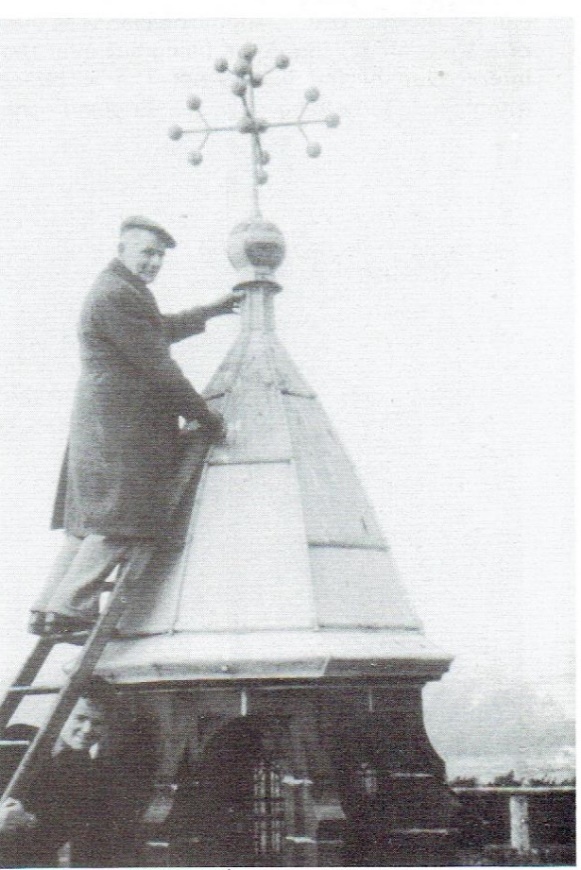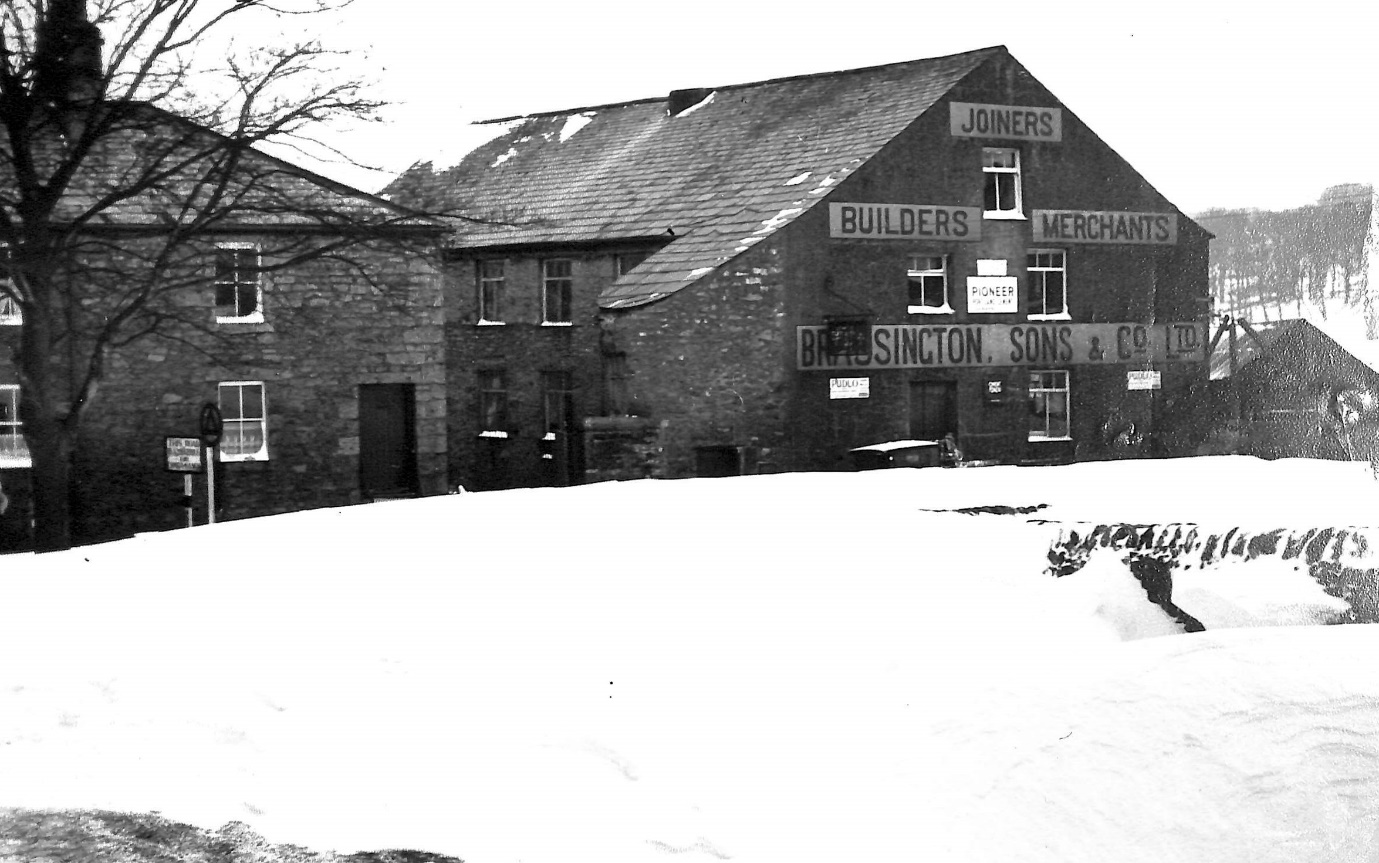| JOURNAL 2020 |
| North Craven Heritage Trust |
In 1861 Bridge End Mill in Settle was purchased and re-opened by Lorenzo Christie along with the other Langcliffe cotton mills. Just how long it was in production is not certain. Henry Brassington was a builder and contractor employing four masons and one labourer in 1871 in Derbyshire and the family had moved to Giggleswick by 1881. When they were looking for a saw mill the building at Bridge End was derelict (presumably part of it) so it was let to them by Christie at a peppercorn rent — the date is not known.
Brassington Bros. and Corney were in business by 1901. Their advertisement noted ‘Fireplaces and Ranges, Ovens and Stoves, supplied and fixed. Every description of Concrete and Granolothic Work. Sanitary Work carried out on the latest improved principles. Drains thoroughly tested’. The business had the building for use as a warehouse, workshop and saw mill. The water-wheel was renovated and they installed water-powered wood-working machines. By 1919 the company was registered as Brassington Son and Co. Ltd.
The directors in 1959 were Fred and John (Jack) Mason Brassington. When I applied in 1959 at the age of 15 to work there, straight from school (having already been offered a job by Jack when I was 13), the company was advertised as Joiners, Builders, Builders Merchants and Plumbers. Sledges were a notable product! A few weeks into my employment I was asked by Jack ‘Do you have a suit?’ Luckily I did, as it turned out that Brassingtons also carried out funerals and I was required to be a bearer (at the age of just 15). The rate of pay for funerals was 15 shillings for less than two hours work. This was quite lucrative as my weekly starting pay was 1s 2d an hour for a 44 hour week, being 8 hours for 5 days and 4 hours on Saturday, making £2 11s 2d a week. We had two weeks paid holidays a year plus Bank Holidays. In 2019 apprentices were paid a statutory minimum wage of £3.90 per hour for those under the age of 18.
I trained as an apprentice joiner, going on day-release and then three nights per week to Craven College to gain my City and Guilds certificate in carpentry and joinery and AWRCC Craft Certificate. The first 12 months were probationary then at the age of 16 the apprenticeship papers were signed, and I graduated at the age of 21 after 5 years. Wood-working machinery was already installed in the mill (around 13 machines, including a mortar pan), all powered by the water-wheel. When the river was low, the wheel could be kept going for a couple of hours with water from the dam in the morning and a couple of hours in the afternoon when the dam had refilled.
Much of the work undertaken by the workforce involved building alterations and refurbishment of properties around Settle and in nearby villages, including Giggleswick, Slaidburn and Ingleton for example. Most local townships had their own small businesses of a similar nature, partly because travel to a job could be a limiting factor. For transport of equipment and goods Brassingtons used one of the director’s cars, a tipper-wagon, a Land Rover, a hand-cart, a bicycle, and Shank’s pony.
The workforce at the time was about 16 men (and one lady in the office) together with three apprentices. One of the first jobs I worked on was modernizing Milnthorpe’s antiques shop and dwelling near the Market Place. I was involved in the conversion of what had been Hector Christie’s Sports Club recreation building on Langcliffe Lodge Road into a house for Mr and Mrs Bill Bentley. Ribblesdale House in Stainforth was also modernized throughout for Lady Colby.
Work on farm buildings such as Arnford Farm in Long Preston involved re-roofing a barn and a new shippon for the animals — without the use of scaffolding or the usual modern safety regulations.
Slaidburn Church was re-roofed in 1960/1961. One of the workmen was tempted to remove a coin from the collection plate (for safe-keeping) and was shouted at by another of the workmen high on the roof who saw what was happening. The guilty party was sure it was Jesus telling him not to do it!
The Black Horse in Giggleswick was updated with a new bar and toilets and general make-over. The landlord’s sister, Helen Frazer, was famous for appearing in the Dick Emery television show (TV in black and white of course). The Yorkshire cricketer Don Wilson had joined Brassingtons a few years earlier, also at the age of 15 as an apprentice joiner (despite the dust, which was not good for his asthma). Don played in six Test matches in India and New Zealand, but needed the job in the winter months with Brassingtons when the cricket season finished. See Settle and District Community News of August 2019 for an extended article about Don by Ian Gray.
I worked with Don and other colleagues on a stage extension at Giggleswick School — and at the other end of the scale making curtain pelmets for the Harts Head in Giggleswick — trundled there in the hand-cart. Work was done in Station Road in the Horner Room and what is now Peggy’s hairdresser salon below, which were used for local meetings after the Horner photography business closed.
Rather different was the job of replacing the chandeliers in Giggleswick Church which required delicate work balancing on a ladder — perhaps not in the way it would be done today. Six of the bungalows on Brackenber Close were constructed by Brassingtons, including all the joinery work. Refurbishment of the Royal Oak in Settle was one of the last jobs I did.
I left the company in 1966, well-trained in an informal way and well-enough set up for the next 40 years or so of employment before retirement. I got to know so many Settle residents and the buildings they worked and lived in. I trust there are no complaints about the standard of workmanship!
Brassingtons closed in 1969. Jack Mason continued as a funeral director but his son, John, moved on to work elsewhere. Jack retired finally in 1991/2 aged 89. The buildings they used were converted in later years into apartments.

A generation of employees © John Reid

Thomas Brassington (ex W.R. Mitchell Gossip from Giggleswick 1988)

Jack Brassington on Giggleswick School Chapel - © John Reid

Premises in 1940